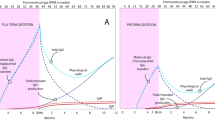Abstract
Babesiosis is a parasitic infection of the red blood cells most often acquired by a tick bite. As it has also been known to be transmitted vertically and via transfusion, neonates have occasionally been reported with the infection. Here, we report a series of three premature neonates who acquired babesiosis via blood transfusion from a single donor, one of whom had difficulty clearing the infection and required multiple antimicrobials.
This is a preview of subscription content, access via your institution
Access options
Subscribe to this journal
Receive 12 print issues and online access
$259.00 per year
only $21.58 per issue
Buy this article
- Purchase on Springer Link
- Instant access to full article PDF
Prices may be subject to local taxes which are calculated during checkout

Similar content being viewed by others
References
Krause PJ . Babesiosis. Med Clin North Am 2002; 86 (2): 361–373.
Vannier E, Krause PJ . Update on babesiosis. Interdiscip Perspect Infect Dis 2009; 2009: 984568.
New DL, Quin JB, Qureshi MZ, Sigler SJ . Vertically transmitted babesiosis. J Pediatr 1997; 131: 163–164.
Sethi S, Alcid D, Kesarwala H, Tolan RW Jr . Probable congenital babesiosis in infant, New Jersey, USA. Emerg Infect Dis 2009; 15 (5): 788–791.
Esernio-Jenssen D, Scimeca PG, Benach JL, Tenenbaum MJ . Transplacental/perinatal babesiosis. J Pediatr 1987; 110: 570–572.
Aderinboye O, Syed SS . Congenital babesiosis in a four-week-old female infant. Pediatr Infect Dis J 2010; 29 (2): 188.
Wittner M, Rowin KS, Tanowitz HB, Hobbs JF, Saltzman S, Wenz B et al. Successful chemotherapy of transfusion babesiosis. Ann Intern Med 1982; 96 (5): 601–604.
Fox LM, Wingerter S, Ahmed A, Arnold A, Chou J, Rhein L et al. Neonatal babesiosis: case report and review of the literature. Pediatr Infect Dis J 2006; 25 (2): 169–173.
Dobroszycki J, Herwaldt BL, Boctor F, Miller JR, Linden J, Eberhard ML et al. A cluster of transfusion-associated babesiosis cases traced to a single asymptomatic donor. JAMA 1999; 281 (10): 927–930.
Tonnetti L, Eder AF, Dy B, Kennedy J, Pisciotto P, Benjamin RJ et al. Transfusion-transmitted Babesia microti identified through hemovigilance. Transfusion 2009; 49 (12): 2557–2563.
Asad S, Sweeney J, Mermel LA . Transfusion-transmitted babesiosis in Rhode Island. Transfusion 2009; 49 (12): 2564–2573.
Kjemtrup AM, Lee B, Fritz CL, Evans C, Chervenak M, Conrad PA . Investigation of transfusion transmission of a WA1-type babesial parasite to a premature infant in California. Transfusion 2002; 42 (11): 1482–1487.
American Academy of Pediatrics. Pickering LK, Baker CJ, Kimberlin DW, Long SS . Red Book: 2009 Report of the Committee on Infectious Diseases. 28th edn. American Academy of Pediatrics: Elk Grove Village, IL, 2009, pp. 784–810, Table 4.9.
Kurkjian KM, Marshall B, Kumar P, Koch W, Mismas M, Garrett J et al., Tranfusion-associated babesiosis among three neonates-Virginia, 2009. Council of State and Territorial Epidemiologists Annual Conference, June 2010. Abstract #4973.
McQuiston JH, Childs JE, Chamberland ME, Tabor E . Transmission of tick borne agents of disease by blood transfusion: a review of known and potential risks in the United States. Transfusion 2000; 40: 274–284.
Krause PJ, Lepore T, Sikand VK, Gadbaw Jr J, Burke G, Telford III SR et al. Atovaquone and azithromycin for the treatment of babesiosis. N Engl J Med 2000; 343 (20): 1454–1458.
Raju M, SAlzar JC, Leopold H, Krause PJ . Atovaquone & Azithromycin treatment for babesiosis in an infant. Pediatr Infect Dis J 2007; 26: 181–183.
Kim KY, Choi JW, Sohn YM, Chung KS . A prospective study of development of splenic reticuloendothelial function in premature and term infants. Yonsei Med J 1980; 21 (2): 110–115.
Krause PJ, Gewurz BE, Hill D, Marty FM, Vannier E, Foppa IM et al. Persistent and relapsing babesiosis in immunocompromised patients. Clin Infect Dis 2008; 46 (3): 370–376.
Acknowledgements
The authors would like to acknowledge Jean Garrett of the CJW Hospital Clinical Laboratory and Mary Mismas of the DCLS for their technical assistance with evaluation of numerous blood specimens for parasitemia. We would also like to acknowledge the assistance of Barbara Herwaldt and other members of the CDC Division of Parasitic Diseases for their review and confirmation of parasitemia in these infants.
Author information
Authors and Affiliations
Corresponding author
Ethics declarations
Competing interests
The authors declare no conflict of interest.
Rights and permissions
About this article
Cite this article
Kumar, P., Marshall, B., deBlois, G. et al. A cluster of transfusion-associated babesiosis in extremely low birthweight premature infants. J Perinatol 32, 731–733 (2012). https://doi.org/10.1038/jp.2012.33
Received:
Accepted:
Published:
Issue Date:
DOI: https://doi.org/10.1038/jp.2012.33



